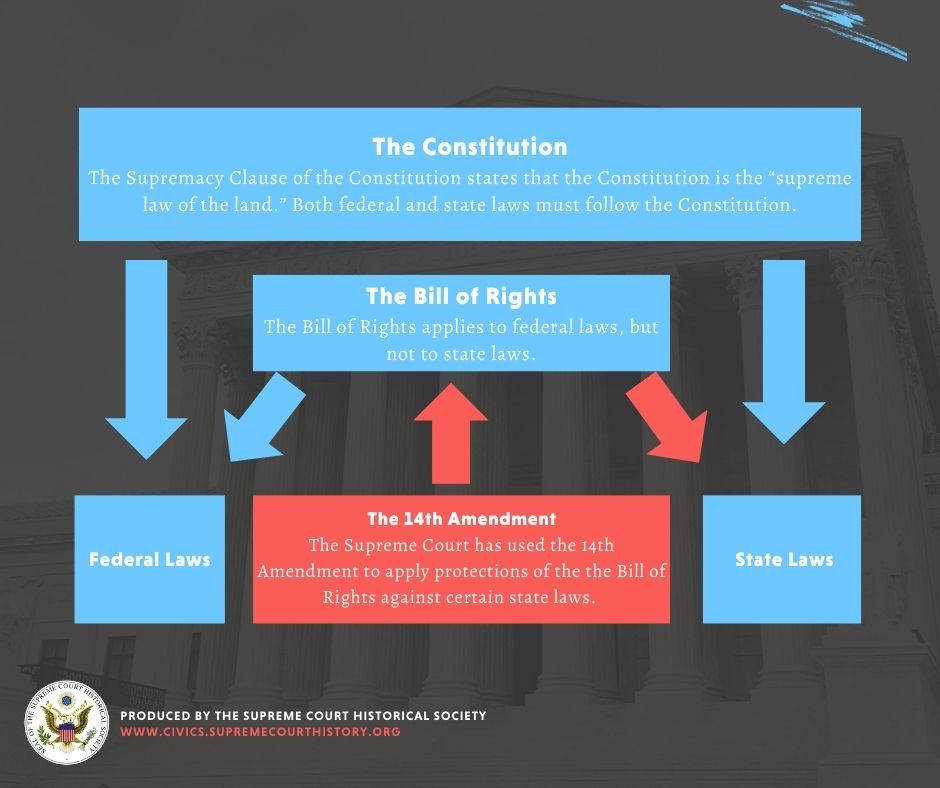Selective Incorporation
The Supreme Court’s case-by-case application of the Bill of Rights to the states through the Fourteenth Amendment
What is selective incorporation?
Selective incorporation is the case-by-case application of the Bill of Rights to the states through the Fourteenth Amendment. It is used to limit state regulations that may infringe on civil rights and liberties. When the Bill of Rights was added to the Constitution in 1791, its protections only applied to the federal government, not the state governments. In 1868, during Reconstruction, Congress ratified the Fourteenth Amendment, extending equal protection and due process to all persons in the United States in 1868. While the Amendment was mainly intended to protect the rights of newly-freed people, citizens began to seek the Supreme Court’s review of state laws and procedures they believe infringed on other rights under the Bill of Rights. The Court used selective incorporation to protect people from state infringements on Constitutional rights, such as freedom of speech, beginning in 1925.
How is selective incorporation applied?
The Supremacy Clause states that the Constitution is the “supreme law of the land.” Therefore, both federal and state laws must abide by the words of the Constitution. The Bill of Rights, though, only applied to federal laws. Then, citizens called upon the Supreme Court to rule on whether the Fourteenth Amendment to the Constitution expanded coverage of certain rights under the Bill of Rights applied to the states, too.
Sometimes, the Supreme Court hears a case where a state law appears to be in violation of a civil liberty protected by the Bill of Rights. In this situation, the Court can reason that the law violates the Due Process Clause of the Fourteenth Amendment, which does apply to all states. The amendment states that no state can take away “liberty” without due process of law. If the Court holds that a state law infringes on a “liberty” protected by the Bill of Rights, that amendment is incorporated into the states.

Selective Incorporation and the Warren Court
Selective incorporation became more prominent in the jurisprudence of the Supreme Court under Chief Justice Earl Warren (1953-1969). During this time, many challenges to state laws and practices under criminal laws were brought to the Court. Throughout the 1960s, the Court used selective incorporation to apply certain protections in the Bill of Rights to state criminal procedures.
For example, Miranda v. Arizona (1966) held that law enforcement must advise persons in custody of their right to remain silent. Chief Justice Warren wrote for the Court that protection from self-incrimination is “essential” to the criminal justice system as it is one of the provisions of the Fifth Amendment. As the Fourteenth Amendment guarantees that equal protection and due process of law extend to all persons, state laws may not infringe upon those rights. Therefore, the Supreme Court incorporated the Fifth Amendment to the states through its decision in Miranda v. Arizona.
The Warren Court also incorporated the Fourth and Sixth Amendments, which also address the rights of the accused in criminal cases. Mapp v. Ohio (1961) incorporated the exclusionary rule of the Fourth Amendment, enhancing protection from unreasonable search and seizure. The right to a lawyer, guaranteed by the Sixth Amendment, was incorporated by the Court in Gideon v. Wainwright (1963).
The First Amendment
-
1925
Gitlow v. New York

Incorporated the First Amendment right to freedom of speech
-
1931
Near v. Minnesota

Incorporated the First Amendment right to freedom of press
-
1936
DeJonge v. Oregon

Incorporated the First Amendment’s freedom of assembly
-
1939
Hauge v. CIO

Incorporated the First Amendment’s freedom of petition
-
1940
Cantwell v. Connecticut

Incorporated the First Amendment’s free exercise of religion
-
1947
Everson v. Board of Education

Incorporated the First Amendment’s Establishment Clause regarding religion
-
1962
Engel v. Vitale

Strengthened the protection of the First Amendment’s freedom of religion
-
1964
New York Times Company v. Sullivan
The Supreme Court decision that arose during the Civil Rights Movement and protected freedom of the press
-
1969
Brandenburg v. Ohio

Strengthened the protection of the First Amendment freedoms of speech and press
The Second Amendment
The Fifth Amendment
-
1897
Chicago, Burlington, and Quincy Railroad Company v. Chicago

Incorporated the Fifth Amendment’s guarantee to compensation for the taking of private property
-
1964
Malloy v. Hogan

Incorporated the Fifth Amendment protection against self-incrimination
-
1966
Miranda v. Arizona

Reaffirmed the incorporated the Fifth Amendment protection against self-incrimination and established the “Miranda warning”
-
1969
Benton v. Maryland

Incorporated the Fifth Amendment protection from double jeopardy
The Sixth Amendment
-
1948
In re Oliver

Incorporated the Sixth Amendment right to a public trial
-
1965
Pointer v. Texas

Incorporated the Sixth Amendment right to confrontation and cross-examination of witnesses
-
1967
Klopfer v. North Carolina

Incorporated the Sixth Amendment right to a speedy trial
-
1968
Duncan v. Louisiana

Incorporated the Sixth Amendment right to a jury trial
-
1967
Washington v. Texas

Incorporated the Sixth Amendment right to compulsory process to obtain witnesses
-
1963
Gideon v. Wainwright

Incorporated the Sixth Amendment right to counsel in felony trials
Extension Activity
Select one of the significant cases above. Create a diagram or flowchart of how that case implemented selective incorporation.
Sources
Special thanks to scholar and professor Michael Ross for his review, feedback, and additional information.
“Modern Doctrine on Selective Incorporation of the Bill of Rights.” Constitution Annotated: Analysis and Interpretation of the U.S. Constitution. https://constitution.congress.gov/browse/essay/amdt14-S1-4-3/ALDE_00013746/.
Hudson, David L. Jr. “The Fourteenth Amendment and Incorporation.” Insights on Law & Society 17, no. 2 (2017): 27-29. American Bar Association.
